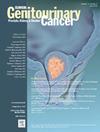引入PSMA-PET/CT对丹麦男性前列腺癌诊断的影响
IF 2.7
3区 医学
Q3 ONCOLOGY
引用次数: 0
摘要
背景:新诊断前列腺癌患者的常规影像学检查正逐渐被PSMA-PET/CT所取代。然而,新的成像方式对阶段迁移的可能影响尚不清楚。我们研究了引入PSMA-PET/CT对新诊断的激素敏感性前列腺癌发病率的影响。患者和方法:这项以人群为基础的全国性研究包括所有出生于1920年至1970年并在2010年至2022年期间被诊断患有前列腺癌的丹麦男性(N = 58,635)。前列腺癌诊断和诊断检查的信息从前瞻性维护的全国登记中检索。在最后一次随访日期(2024年8月11日)之前检索死亡原因。采用多变量线性回归、逻辑回归和因由特异性Cox比例风险进行估计。结果:每进行一次PSMA-PET/CT检查,转移诊断的数量增加0.29(95%可信区间[CI]: 0.21-0.38, P < .001),主要是由PSMA-PET/CT使用较高的地区驱动的。接受PSMA-PET/CT检查增加了前列腺低转移灶放射治疗(优势比:4.1,95% CI: 3.5-4.9)或化疗(优势比:1.27,95% CI: 1.04-1.56)的可能性。在所有被诊断患有前列腺癌的男性中,只有在PSMA-PET/CT使用率高的地区,5年前列腺癌特异性死亡率才会下降,从2010年至2014年诊断时的15% (95% CI: 14-16)降至2019年至2022年诊断时的13% (95% CI: 12-14)。结论:我们的数据显示,在全国范围内实施PSMA-PET/CT导致前列腺癌分期迁移,与PSMA-PET/CT使用率最高的地区前列腺癌特异性死亡率略有下降相一致。本文章由计算机程序翻译,如有差异,请以英文原文为准。
The Influence of the Introduction of PSMA-PET/CT in Danish Men Diagnosed with Prostate Cancer
Background
Conventional imaging in patients with newly diagnosed prostate cancer is gradually being replaced with PSMA-PET/CT. However, the possible impact of newer imaging modalities on stage migration is poorly understood. We have studied the effects of introducing PSMA-PET/CT on the incidence of newly diagnosed hormone-sensitive prostate cancer.
Patients and methods
This population-based nationwide study included all Danish men born between 1920 and 1970 and diagnosed with prostate cancer between 2010 and 2022 (N = 58,635). Information on prostate cancer diagnosis and diagnostic workup was retrieved from prospectively maintained nationwide registries. Cause of death was retrieved until the last date of follow-up (August 11, 2024). Multivariable linear regression, logistic regression, and Cause-specific Cox proportional hazards were utilized to obtain estimates.
Results
Each PSMA-PET/CT performed increased the number of metastatic diagnoses by 0.29 (95% confidence interval [CI]: 0.21-0.38, P < .001), primarily driven by regions with a higher use of PSMA-PET/CT. Having PSMA-PET/CT performed increased the likelihood of having the therapies radiation to the prostate in an oligometastatic setting (Odds ratio: 4.1, 95% CI: 3.5-4.9) or chemotherapy (Odds ratio: 1.27, 95% CI: 1.04-1.56). Five-year prostate cancer-specific mortality in all men diagnosed with prostate cancer decreased only in areas with high PSMA-PET/CT usage, from 15% (95% CI: 14-16) when diagnosed in 2010 to 2014 to 13% (95% CI: 12-14) when diagnosed in 2019 to 2022.
Conclusion
Our data shows that the implementation of PSMA-PET/CT on a nationwide level led to prostate cancer stage migration, coinciding with a slight decrease in prostate cancer-specific mortality in regions with the highest usage of PSMA-PET/CT.
求助全文
通过发布文献求助,成功后即可免费获取论文全文。
去求助
来源期刊

Clinical genitourinary cancer
医学-泌尿学与肾脏学
CiteScore
5.20
自引率
6.20%
发文量
201
审稿时长
54 days
期刊介绍:
Clinical Genitourinary Cancer is a peer-reviewed journal that publishes original articles describing various aspects of clinical and translational research in genitourinary cancers. Clinical Genitourinary Cancer is devoted to articles on detection, diagnosis, prevention, and treatment of genitourinary cancers. The main emphasis is on recent scientific developments in all areas related to genitourinary malignancies. Specific areas of interest include clinical research and mechanistic approaches; drug sensitivity and resistance; gene and antisense therapy; pathology, markers, and prognostic indicators; chemoprevention strategies; multimodality therapy; and integration of various approaches.
 求助内容:
求助内容: 应助结果提醒方式:
应助结果提醒方式:


